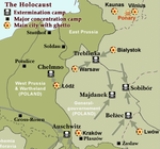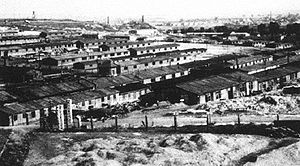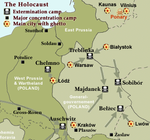
Kraków-Plaszów concentration camp
Encyclopedia


Nazi Germany
Nazi Germany , also known as the Third Reich , but officially called German Reich from 1933 to 1943 and Greater German Reich from 26 June 1943 onward, is the name commonly used to refer to the state of Germany from 1933 to 1945, when it was a totalitarian dictatorship ruled by...
labour and concentration camp built by the SS in Płaszów, a southern suburb of Kraków
Kraków
Kraków also Krakow, or Cracow , is the second largest and one of the oldest cities in Poland. Situated on the Vistula River in the Lesser Poland region, the city dates back to the 7th century. Kraków has traditionally been one of the leading centres of Polish academic, cultural, and artistic life...
(now part of Podgórze
Podgórze
Podgórze is a district of Kraków, Poland, situated on the right bank of the Vistula River. Initially a village at the foot of Lasota Hill was granted city status by the Austrian Emperor Joseph II in 1784 and has become Royal Free City of Podgorze...
district), soon after the German invasion of Poland and the subsequent creation of the General Government
General Government
The General Government was an area of Second Republic of Poland under Nazi German rule during World War II; designated as a separate region of the Third Reich between 1939–1945...
.
The Płaszów camp, originally intended as a forced labour camp, was constructed on the grounds of two former Jewish cemeteries (see, New Jewish Cemetery
New Jewish Cemetery, Kraków
The New Jewish Cemetery in Kraków, Poland covers an area of about . It is located at Street, in the historic Jewish neighborhood of Kazimierz. It is a registered heritage monument along with historic mortuary.-History:...
) in the summer of 1942 during Nazi German occupation of Poland, with deportations of the Jews from the Kraków Ghetto
Kraków Ghetto
The Kraków Ghetto was one of five major, metropolitan Jewish ghettos created by Nazi Germany in the General Government territory for the purpose of persecution, terror, and exploitation of Polish Jews during the German occupation of Poland in World War II...
beginning October 28, 1942. In 1943 the camp was expanded and turned into one of many KL concentration camps
German camps in occupied Poland during World War II
The German camps in occupied Poland during World War II were built by Nazi Germany in the course of its Occupation of Poland both in areas annexed by Germany and in General Gouvernment...
.
Camp operation
Commanding the camp was Amon GöthAmon Göth
Amon Leopold Göth was an Austrian Nazi and the commandant of the Nazi concentration camp at Płaszów, General Government...
, an SS commandant from Vienna
Vienna
Vienna is the capital and largest city of the Republic of Austria and one of the nine states of Austria. Vienna is Austria's primary city, with a population of about 1.723 million , and is by far the largest city in Austria, as well as its cultural, economic, and political centre...
who was known for being uncommonly sadistic in his treatment and killing of prisoners. Göth would never sit down to a breakfast without shooting at least one victim. On March 13, 1943, he personally oversaw the liquidation of the Kraków Ghetto
Kraków Ghetto
The Kraków Ghetto was one of five major, metropolitan Jewish ghettos created by Nazi Germany in the General Government territory for the purpose of persecution, terror, and exploitation of Polish Jews during the German occupation of Poland in World War II...
nearby, forcing its Jewish inhabitants deemed capable of work into the KL Plaszow camp. Those who were declared unfit for work were either sent to Auschwitz or shot on the spot. Under him were his staff of Ukrainian SS personnel, followed by 600 Germans of the SS-Totenkopfverbände
SS-Totenkopfverbände
SS-Totenkopfverbände , meaning "Death's-Head Units", was the SS organization responsible for administering the Nazi concentration camps for the Third Reich....
(1943–1944), and a few SS women, including Gertrud Heise, Luise Danz
Luise Danz
Luise Danz is a former concentration camp guard. She was born in Walldorf , Thuringia.-Camp work:On January 24, 1943 at the age of 26, Luise Danz was conscripted as an Aufseherin within the Nazi concentration camp system. She served as guard in several camps, such as Kraków-Płaszów, Majdanek,...
, Alice Orlowski
Alice Orlowski
Alice Orlowski was a high-ranking SS official at many of the Nazi German camps in occupied Poland during World War II....
and Anna Gerwing.
The camp was a slave Arbeitslager
Arbeitslager
Arbeitslager is a German language word which means labor camp.The German government under Nazism used forced labor extensively, starting in the 1930s but most especially during World War II....
(Labor Camp), supplying manpower to several armament factories and a stone quarry. The death rate in the camp was very high. Many prisoners, including many children and women, died of typhus
Typhus
Epidemic typhus is a form of typhus so named because the disease often causes epidemics following wars and natural disasters...
, starvation and executions. Płaszów camp became particularly infamous for both individual and mass shootings carried out there. Using Hujowa Górka
Hujowa Górka
Hujowa Górka is a place near Kraków-Płaszów concentration camp, where in April 1944 the Nazis exhumed and burnt the bodies of around ten thousand previously killed Jews. The place takes its name from the surname of Unterscharführer Albert Hujar, who is portrayed by Norbert Weisser in Schindler's...
, a large hill close to the camp commonly used for executions, some 8,000 deaths took place outside the camp’s fences with prisoners trucked in 3 to 4 times weekly. The covered lorries from Kraków used to arrive in the morning. The condemned were walked into a trench of the Hujowa Górka
Hujowa Górka
Hujowa Górka is a place near Kraków-Płaszów concentration camp, where in April 1944 the Nazis exhumed and burnt the bodies of around ten thousand previously killed Jews. The place takes its name from the surname of Unterscharführer Albert Hujar, who is portrayed by Norbert Weisser in Schindler's...
hillside and shot, bodies then covered with dirt layer upon layer. In early 1944 all corpses were exhumed and burnt in a heap to hide the evidence. Witnesses later attested that 17 truckloads of human ashes were removed from the burning site, and scattered over the area.

Alice Orlowski
Alice Orlowski was a high-ranking SS official at many of the Nazi German camps in occupied Poland during World War II....
. She held these documents in her possession until the end of the war, then allegedly destroyed them. Alice Orlowski
Alice Orlowski
Alice Orlowski was a high-ranking SS official at many of the Nazi German camps in occupied Poland during World War II....
, a picture-perfect SS-woman, was known for her whippings especially of young women across their eyes. At roll call
Roll call
Roll call is the calling of the names of people from a list to determine the presence or absence of the listed people . The term applies to the calling itself, to the time moment of this procedure, and to a military signal that announces it Roll call is the calling of the names of people from a...
she would walk through the lines of women, and personally whip them.
.jpg)
Stutthof
Stutthof can refer to:*Sztutowo in Poland*Stutthof concentration camp built near Sztutowo...
, Flossenbürg
Flossenbürg
Flossenbürg is a municipality in the district of Neustadt an der Waldnaab in Bavaria in Germany. The state-approved leisure area is located in the Bavarian Forest and borders the Czech Republic in the east. During World War II, the Flossenbürg concentration camp was located here.- History :The...
, Mauthausen
Mauthausen
Mauthausen is a small market town in Upper Austria, Austria. It is located at about 20 kilometers east of the city of Linz, and has a population of 4,850 .During World War II, it became the site of the Mauthausen-Gusen concentration camp complex....
and other camps. In January 1945, the last of the remaining inmates and camp staff, left the camp on a death march
Death march
A death march is a forced march of prisoners of war or other captives or deportees. Those marching must walk over long distances for an extremely long period of time and are not supplied with food or water...
to Auschwitz, including several female SS guards. Many of those who survived the march were killed upon arrival. When the Nazis realized that the Soviets were already approaching Kraków
Kraków
Kraków also Krakow, or Cracow , is the second largest and one of the oldest cities in Poland. Situated on the Vistula River in the Lesser Poland region, the city dates back to the 7th century. Kraków has traditionally been one of the leading centres of Polish academic, cultural, and artistic life...
, they completely dismantled the camp, leaving an empty field in its place. The bodies that were buried there earlier in various mass grave
Mass grave
A mass grave is a grave containing multiple number of human corpses, which may or may not be identified prior to burial. There is no strict definition of the minimum number of bodies required to constitute a mass grave, although the United Nations defines a mass grave as a burial site which...
s were all exhumed and burned on site. On January 20, 1945 the Red Army
Red Army
The Workers' and Peasants' Red Army started out as the Soviet Union's revolutionary communist combat groups during the Russian Civil War of 1918-1922. It grew into the national army of the Soviet Union. By the 1930s the Red Army was among the largest armies in history.The "Red Army" name refers to...
had reached only a tract of barren land.
The area which held the camp now consists of sparsely wooded hills and fields with one large memorial marking where the camp once stood, with an additional small plaque located near the opposite end of the site. The camp is featured in the movie Schindler's List
Schindler's List
Schindler's List is a 1993 American film about Oskar Schindler, a German businessman who saved the lives of more than a thousand mostly Polish-Jewish refugees during the Holocaust by employing them in his factories. The film was directed by Steven Spielberg, and based on the novel Schindler's Ark...
about the life of Oskar Schindler
Oskar Schindler
Oskar Schindler was an ethnic German industrialist born in Moravia. He is credited with saving over 1,100 Jews during the Holocaust by employing them in his enamelware and ammunitions factories, which were located in what is now Poland and the Czech Republic respectively.He is the subject of the...
.
See also
- List of subcamps of Kraków-Płaszów
- List of Nazi concentration camps
- Oskar SchindlerOskar SchindlerOskar Schindler was an ethnic German industrialist born in Moravia. He is credited with saving over 1,100 Jews during the Holocaust by employing them in his enamelware and ammunitions factories, which were located in what is now Poland and the Czech Republic respectively.He is the subject of the...

